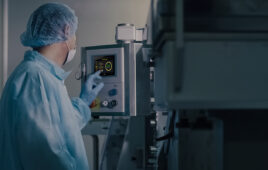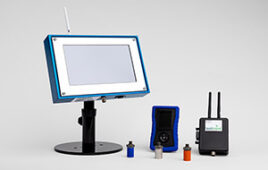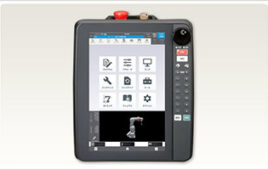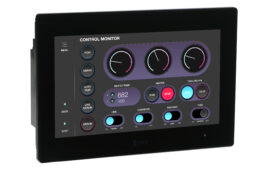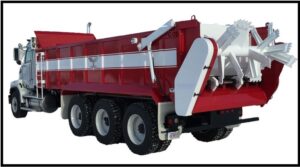
Manure spreaders have a tandem hydraulic pump. One pump drives the beater system at the backend that spreads, or applies, the product onto the field. A hydraulically driven end gate, or tailgate, opens up to allow the product out the backend, and the system also has a hydraulically driven variable speed floor.
One of the key challenges of this century is to find solutions for ensuring access to healthy, diverse, and safe food for a growing global population while limiting the impact on the environment. Advancing sustainability and efficiency with IIoT innovation in today’s agriculture are a central part of the solution.
In 2020, Travis Jones, co-owner of McKee Ag Solutions, decided it was time for a digital transformation. “We wanted to provide our customers a remote diagnostic web portal that they could log in and see various functions of the machine,” said Jones.
Jones asked TRS Systems, an IIoT integrator and service provider, to design and deploy a solution for the McKee Ag. Two mechanical engineers, Curtis Steele and Rav Singh, brought their experience working with hydraulics, electronic control systems, and IIoT-based cloud integration to digitally transform manure spreading process.
This was a two-step challenge: Step one was the control automation of the manure spreader. Step two was the on-the-Cloud Integration of the manure spreader.
Step one: Summary benefit control automation of the manure spreader.
When the operator drives the machine onto the field, he can essentially hit one auto button, and the whole machine starts working. The operator can then concentrate on navigating the field and covering it systematically. The desired solution should be easy to program and saleable, yet the engineering should make quick changes to the program logic if needed.
Step two: Summary benefit of the bi-directional communication between the manure spreader and the Cloud.
Step two of the solution uses variable rate technology (VRT) and remote diagnostics with Data Logging. VRT is the ability to vary the amount of fertilizer or other farm inputs based on variations in the soil or crop. VRT is an advanced objective in precision farming, or smart agriculture, and has several benefits.
For one, it can reduce the amount of wasted product applied to the field. By using sensor-based VRT or map-based VRT, the goal is to detect information about the landscape and use it to make instant real-time decisions on product application. Variable rate technology, then, leads to optimized output, conservation, sustainability, and high-level informed decision-making for any agricultural operation.
Solution Part One: Control Automation of the Manure Spreader
Overview of Manure Spreader Components and Control System
Manure spreaders have a tandem hydraulic pump. One pump drives the beater system at the backend that spreads, or applies, the product onto the field. A hydraulically driven end gate, or tailgate, opens up to allow the product out the backend, and the system also has a hydraulically driven variable speed floor.
An essential function of the control system is to monitor the torque load on the beater. With the beater requiring the highest horsepower load, it is crucial to use a pressure control, essentially a torque control, to keep the entire operation under the maximum load the drive line can handle. For example, if the operator is driving the floor too fast, which increases the pressure, the control system will stop the floor or slow it down based on the load on the beater.
The key functions TRS Systems developed for McKee Ag are auto end gate control, automatic floor control, constant rate functions, and alarms and diagnostics.
Using the end gate auto function, the operator can hit a button and the end gate will go up and automatically stop based on the pressure. The floor auto function works in unison with the end gate auto. When the operator drives the machine onto the field, he can essentially hit one auto button, and the whole machine starts working. The operator can then concentrate on navigating the field and covering it systematically.
The constant-rate feature allows the operator to set the tons per acre and spread width for the actual width of the beater, and the floor will be controlled automatically.
Alarms and diagnostics are also important built-in features. For example, there are alarms to indicate excessively high temperatures in the hydraulic system. This functionality allows for troubleshooting on-site and can help ensure proper maintenance.
TRS Systems used the following hardware components for the control system:
1. Topcon B3 CODESYS-based human machine interface (HMI)
2. Eaton HFX-20m as the main controller, or brain, for the spreader
3. CODESYS-based Immercloud gateway talking to the Cloud and sending various CAN data to McKee’s user interface in the Cloud
4. Danfoss HMR Series keypad for CANbus based control
All of the functions for McKee Ag’s control system were programmed using the CODESYS development environment. Curtis Steele, P.Eng., serving as chief technology advisor to McKee Ag, has more than 14 years of experience designing and programming embedded control systems using CODESYS. With programming software designed to the international industrial standard IEC 61131-3, users can program in any language they feel comfortable with. Steele prefers structured text (ST) and CFC. “But even if you’re used to ladder logic and other languages, it’s just so simple to use.” The function blocks and libraries built over the years can be reused over multiple applications and save so much time.
Also, the built-in SAE J1939 manager and libraries make integrating any piece of hardware easy. For McKee Ag, Steele and Singh integrated the Danfoss HMR CAN rotary encoder. The Danfoss uses a standard SAE J1939 message using the auxiliary I/O 1&2. “All you really have to do is enter in the PGN and a source address, and you can start monitoring button clicks. Again, a really nice feature of CODESYS,” Steele explained.
The other aspect is the CANopen side of the bus management. The application uses CANopen to talk to the HMI and the TRS Systems’ Immercloud Gateway. This gateway runs on CODESYS 3.5 and allows users to just a device, import the EDS file, and start mapping variables.
All of the telematics data flows from the gateway to the cloud. “And also, the gateway provides GPS signal back to the truck and the truck control system over CAN bus,” Singh explained.
Solution Part Two: GPS, VRT, and Cloud Integration
One of the earlier phases of the McKee Ag manure spreader project involved TRS Systems wireframing the HMI. “We really follow the philosophy of WYSIWYG—what you see is what you get,” Singh said. They want their customers to have a good idea of what to expect with their final cloud dashboard and the spreader control screens. And it’s all part of TRS Systems’ mission to simplify IoT for its clients.
Launched into Cloud in less than four weeks
In the first stage of cloud integration for McKee Ag, Singh integrated McKee Ag equipment to the cloud using TRS’ Systems SAAS Solution—Immercloud — in less than four weeks; it was complete.
The remote monitoring dashboard on Immercloud shows information such as number of devices, how many users, and how many active sessions, all on the main login page. In addition, the main dashboard allows remote troubleshooting and shows information such as floor pressure, beater pressure, floor speed, oil temperature, ECU voltage, and alarm information.
The GPS, latitude, longitude, and speed data are sent to the dashboard. Data logged and sent to the cloud includes as-applied data. This is a basic but crucial element because it prevents overlap in product application, which is useful if the operation involves two or more spreaders on the field.
 Variable Rate Control
Variable Rate Control
The second iteration that TRS Systems has worked on was to implement variable rate control, a more advanced functionality.
Variable rate technology is an advanced objective in precision farming, or smart agriculture, and has several benefits. For one, it can reduce the amount of wasted product applied to the field. By using sensor-based VRT or map-based VRT, the goal is to detect information about the landscape and use it to make instant real-time decisions on product applications.
For McKee Ag, variable rate control would help the manure spreaders vary the product application based on the field’s topography. So, for example, if there is a waterhole, the machine can control that spread width and change the rate variably accordingly.
TRS Systems implemented a map-based VRT. Singh has used hyper layer data visualization, which involves splitting the data set into multiple layers:
1. Drainage data
2. Vegetation data
3. User adjustment data
4. As-applied data
The user can enter the drainage data in a GeoJSON format or any leading industry format to the cloud. And the cloud interprets how the natural drainage works on the farm.
The vegetation data layer provides information about the type of crops and vegetation on the field. This is useful because different crops require different types or amounts of manure, and this data layer can determine how much product should be applied on a particular section of the field.
Next, the user adjustment data involves simple geofencing. Singh said, “We use a lasso-type tool that allows the farmer to draw boundaries and their associated rates right onto the tablet. Or we can just import GeoJSON from any existing boundary conditions.”
The top layer consists of as-applied data from previous years. “This gives us the ability to analyze that data — for example, what effect did it have on the particular crop for that particular season?” Singh said.
The variable rate data takes all these layers into account. “The cloud performs the math to calculate the variable rate data,” Singh explained. “The operator is just going to drive on the field and focus on operating the machine. The rate adjustment happens automatically based on the cloud integration.”
What made the entire project for McKee Ag seamless was the usage of CODESYS’ IoT libraries. Singh said it’s what has also allowed him to design custom IoT integration for other clients. He is excited about the future of IIoT and, through TRS Systems, helping businesses make that digital transformation to Industry 4.0.
CODESYS
codesys.us
Filed Under: DIGITAL TRANSFORMATION (DX), Displays • HMIs • operator interfaces • monitors

